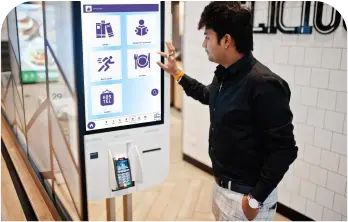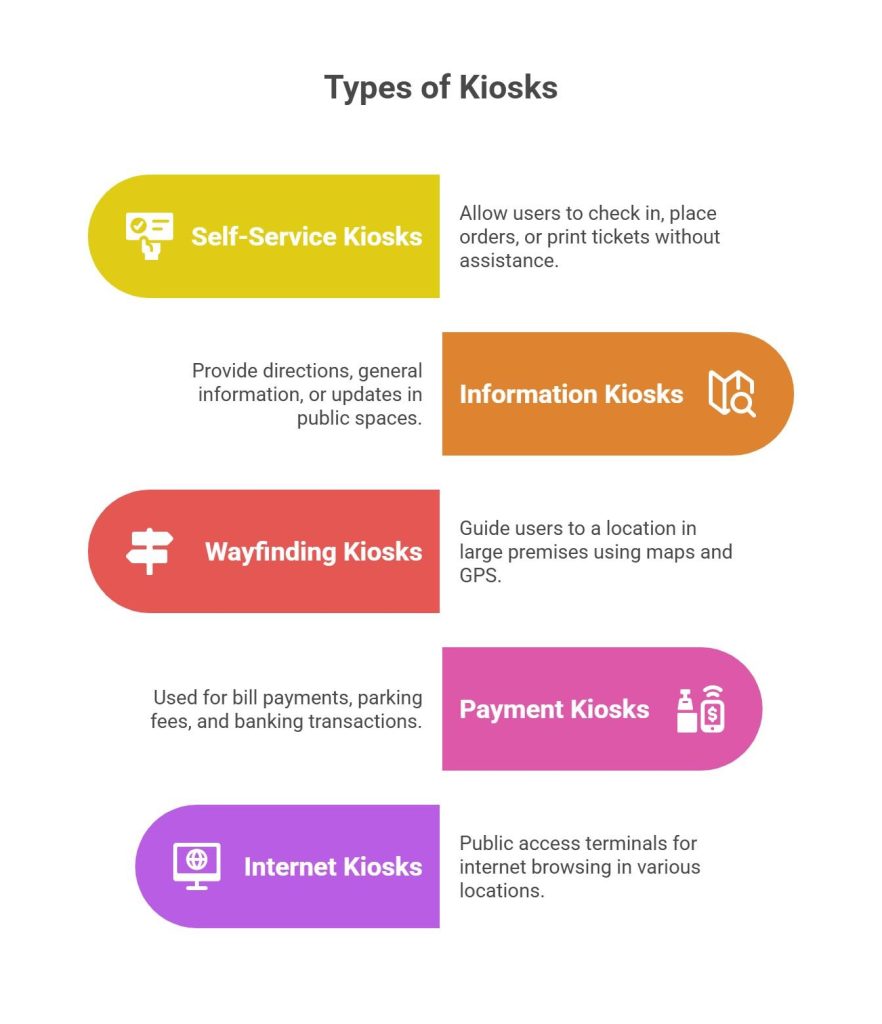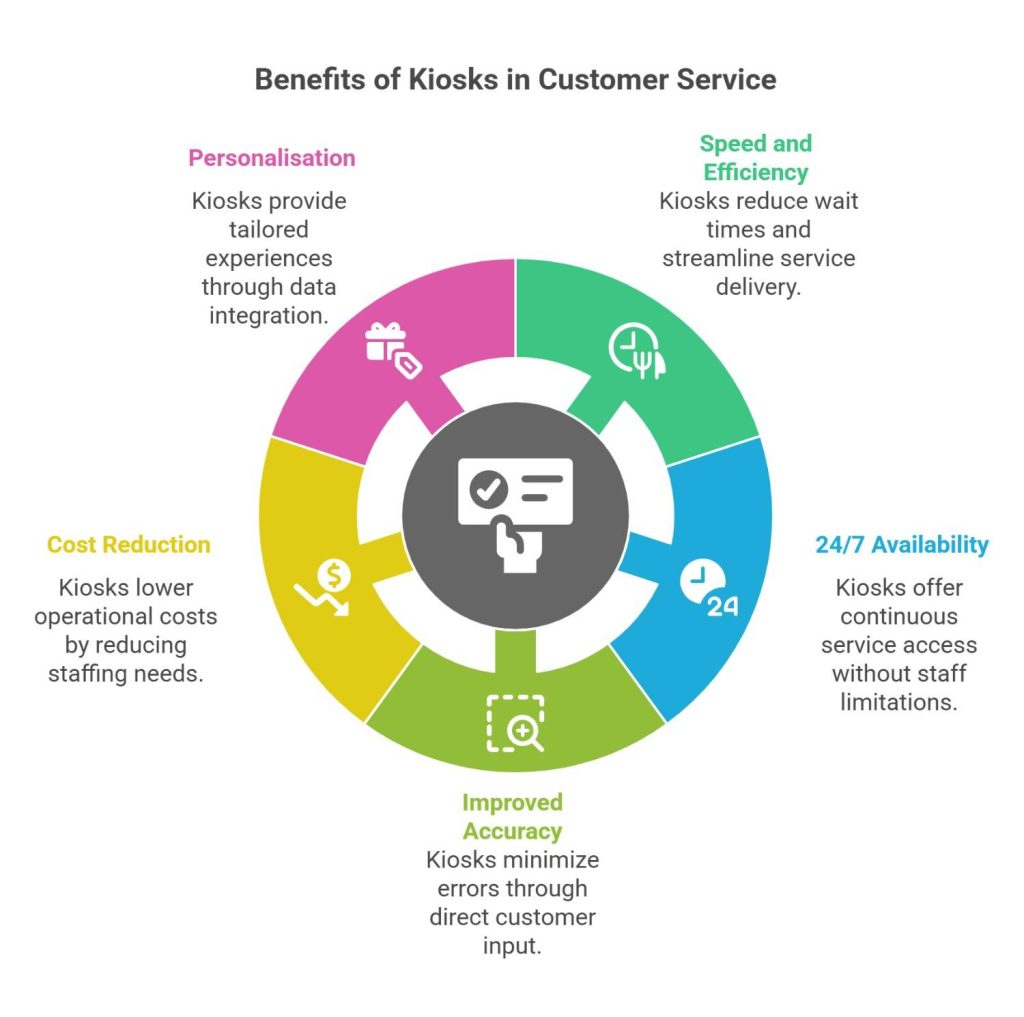Self-service is the foundation of great customer experiences. Kiosk is an interactive technology that blends touchless displays with intuitive features to present unforgettable experiences. But what is a kiosk, exactly? At its core, a kiosk is a self-service station that enables users to access services or information without the need for human interaction.
Whether you’re at a bank, a mall, a hospital, or an airport, kiosks have become a ubiquitous part of modern service environments. Their convenience, efficiency, and adaptability make them an essential touchpoint in today’s customer service journey. This blog explores what a kiosk is, its different types, its growing role in modern customer service, and why it’s shaping the future of user interaction.

What is a Kiosk?
To put it simply, what is a kiosk? It’s a standalone digital or non-digital terminal that allows people to perform specific tasks such as checking in, placing orders, making payments, or obtaining information. Modern kiosks are typically equipped with a touch screen, printer, scanner, card reader, or even biometric systems, depending on the use case.
These units can be interactive or static, placed indoors or outdoors, and customised to suit a specific business or organisational need. When people ask, What is a kiosk, they’re often referring to the interactive digital terminals that facilitate self-service in customer-centric spaces.
The Evolution of Kiosks
What is a kiosk? It’s important to look at its evolution. The concept originated with simple booths or stands selling newspapers, snacks, or souvenirs. Over time, these evolved into automated machines designed to offer fast service, reduce wait times, and lessen the dependency on staff.
In the early 2000s, touchscreen technology and internet connectivity paved the way for digital kiosks, making them smarter and more integrated with backend systems. Fast forward to today, and we see kiosks offering personalised experiences through AI, data analytics, and cloud computing.
Types of Kiosks in Use Today

When businesses consider kiosk architecture and how it can be used, they often think in terms of application. Here are the common kiosk types that are used in diverse industries to manage customer expectations:
1. Self-Service Kiosks
Found in fast food restaurants, cinemas, and airports, these allow users to check in, place orders, or print tickets without human assistance.
2. Information Kiosks
Common in malls, museums, and government offices, these provide directions, general information, or updates.
3. Wayfinding Kiosks
Integrated with maps and GPS, these guide users to a particular location in large premises such as hospitals or university campuses.
4. Payment Kiosks
Used for bill payments, parking fees, and banking transactions. These are often seen in metro stations, banks, or retail outlets.
5. Internet Kiosks
Public access terminals that allow internet browsing, particularly in airports, libraries, and rural areas.
So, when someone asks what a kiosk is, it’s evident that there are many interpretations depending on its purpose.
Why Kiosks Are Integral to Modern Customer Service

In today’s experience-driven economy, businesses need to deliver speed, convenience, and personalization. Kiosks help achieve all three. Let’s explore why understanding what a kiosk is is essential for any organisation looking to improve its customer service game.
1. Speed and Efficiency
Kiosks promote fast service and cut down long queues. This is especially critical in high-traffic areas like airports or quick-service restaurants.
2. 24/7 Availability
Unlike staff who work in shifts, kiosks can operate around the clock, offering customers access to services anytime.
3. Improved Accuracy
By allowing customers to input their own data, kiosks reduce the chance of human error, especially in ordering and payment systems.
4. Cost Reduction
Although initial setup can be expensive, kiosks reduce long-term staffing costs and boost overall operational efficiency.
5. Personalisation
Modern kiosks can be integrated with customer data to provide personalised product suggestions, services, or loyalty rewards.
Understanding what a kiosk is goes beyond hardware—it’s about recognising the benefits of this technology in reshaping interactions.
Industries That Benefit the Most – Kiosk Application
To further appreciate what a kiosk is, we need to examine where it’s making the biggest impact:
- Retail: Self-checkout kiosks and interactive catalogues enhance the shopping experience.
- Healthcare: Patient check-in kiosks reduce wait times and improve data accuracy.
- Hospitality: Hotels use kiosks for self-check-in, room selection, and key dispensing.
- Transportation: Ticketing kiosks streamline travel for buses, trains, and airlines.
- Education: Campus information kiosks provide student support and navigation assistance.
In all these scenarios, the core question is: What is a kiosk?—becomes synonymous with efficiency and user empowerment.
Challenges of Implementing Kiosks
Despite their benefits, deploying kiosks isn’t without hurdles. Businesses must consider:
- Initial Investment: High setup and maintenance costs.
- User Adaptability: Some customers may still prefer human interaction.
- Security Concerns: Protecting user data on public devices is critical.
- Regular Maintenance: Kiosks require frequent updates and technical support.
These factors are crucial when evaluating what a kiosk is in terms of ROI and customer adoption.
The Future of Kiosks in Customer Service
The future of self-service kiosks lies in advanced integration. With AI, Iot, and real-time analytics, kiosks are set to become smarter, more intuitive, and even predictive.
- Voice-enabled kiosks will serve visually impaired users or improve convenience.
- Biometric authentication will make transactions safer.
- Multilingual support will break language barriers in diverse regions.
- Understanding what a kiosk is today will prepare businesses for the intelligent kiosks of tomorrow.
What is the definition of a kiosk? You have understood this. Let’s explore the FAQ section.
Conclusion
So, what is a kiosk? It’s not just a piece of equipment—it’s a gateway to faster, more personalised, and efficient customer service. As consumers continue to expect seamless, tech-driven experiences, kiosks are evolving to meet these demands across industries.
For businesses looking to stay ahead, understanding what a kiosk is and leveraging its potential could mean the difference between customer frustration and customer delight. Want a customized solution for supply chain optimization? Contact Qodenext today.
FAQS: What Is a Kiosk?
1. What is the meaning of kiosk?
A kiosk is a standalone station that allows users to perform tasks such as making payments, retrieving information, or placing orders without human assistance.
2. How is a kiosk used in customer service?
Kiosks streamline services by reducing wait times, improving order accuracy, and offering 24/7 self-service capabilities.
3. What industries use kiosks the most?
Retail, healthcare, hospitality, transportation, and education are some of the top sectors that benefit from kiosk technology.
4. Are kiosks replacing human employees?
Not entirely. While kiosks reduce the need for certain roles, they often work alongside employees to improve overall service quality.
5. Can kiosks be customized for small businesses?
Absolutely. Many vendors offer modular or scalable kiosk solutions tailored to the needs and budget of small and medium businesses.
6. What is a kiosk’s role in digital transformation?
Kiosks represent a critical step toward automation and self-service, key components of any digital transformation strategy.






